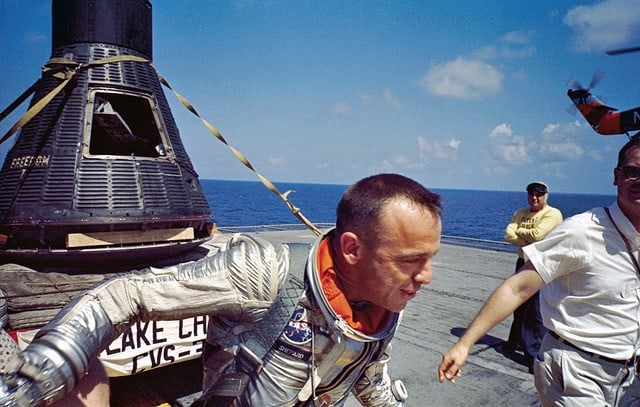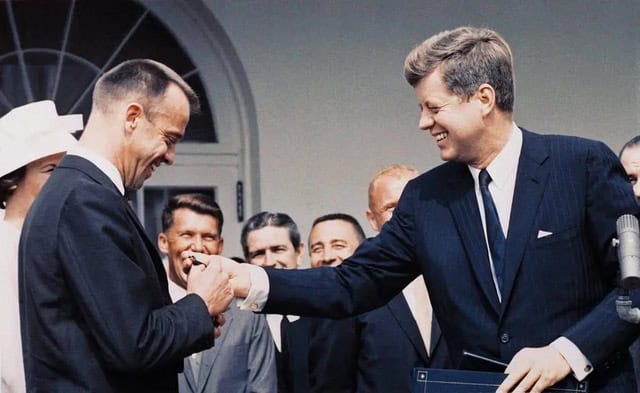
Astronaut Alan B. Shepard on the deck of the USS Lake Champlain after the recovery of his Mercury capsule in the western Atlantic Ocean

President Kennedy presenting the Distinguished Service Medal to Alan Shepard
By Yonkers City Historian Mary Hoar
May 5,1961, millions of Americans were glued to televisions and radios… scared and praying.
Early that morning, Navy Commander Alan B. Shepard, Jr., wearing a specially designed pressurized space suit, climbed into the one-person Mercury spacecraft he named Freedom 7.
Yonkers accompanied Shepard into space that day. Spartan Hydraulics on Saw Mill River Road, a McDonnell Aircraft subcontractor, designed and manufactured the eight check valves on the Freedom 7 space capsule, right here in Yonkers! The valves automatically controlled the flow of hydrogen peroxide through the chamber controlling the yaw, pitch and roll of the capsule; in a case of emergency, Shepard manually could control the valves.
Piloting Mercury spacecraft Freedom 7, he flew 116 miles into the air, then headed back to earth, a 302-mile suborbital flight. Shepard continually reported during the flight everything was “OK.”
The capsule parachuted into the Atlantic 15 minutes 22 seconds after take-off, an eternity to those waiting for his safe return.
Picked up by a Marine helicopter at 10:53 am, Shepherd was brought to the Naval pickup operation primary recovery ship, the USS Lake Champlain.
Four Yonkers sailors were on the Champlain to cheer this American achievement: Signalman Third Class Edward Delapp of William Street; Seaman Robert France of Walnut Street; Seaman Neil Graner of Corley Street; and Shipfitter Third Class Paul Savage of Hudson Street.
The Lake Champlain crew were told not to speak to the Shepard at any time; the medical staff didn’t want his report influenced by anything the men said. He spent two days on Grand Bahama Island debriefing, then headed back to the US.
Three days later, Alan B. Shepard, Jr., was in Washington DC; President John Kennedy presented him with the Distinguished Service Medal May 8, 1961.
In June, while speaking to research scientists and doctors at a conference on the medical implications of suborbital flight, Shepard revealed vibration from the rocket launch briefly fogged his vision, and steps were underway to reduce the shaking. He also said the few minutes of weightlessness did not affect his breathing or speaking. The worst part? The medical staff used too many needles during the many pre-flight medical exams!
Five weeks later on June 13th, wanting to keep his name in the hearts of Yonkers, our City Council voted 7-6 to honor our first American in space. They changed the name of two-block-long Tibbetts Place to Alan B. Shepard, Jr. Place, a small street that would have only one home with the Alan B. Shepard Place address.





